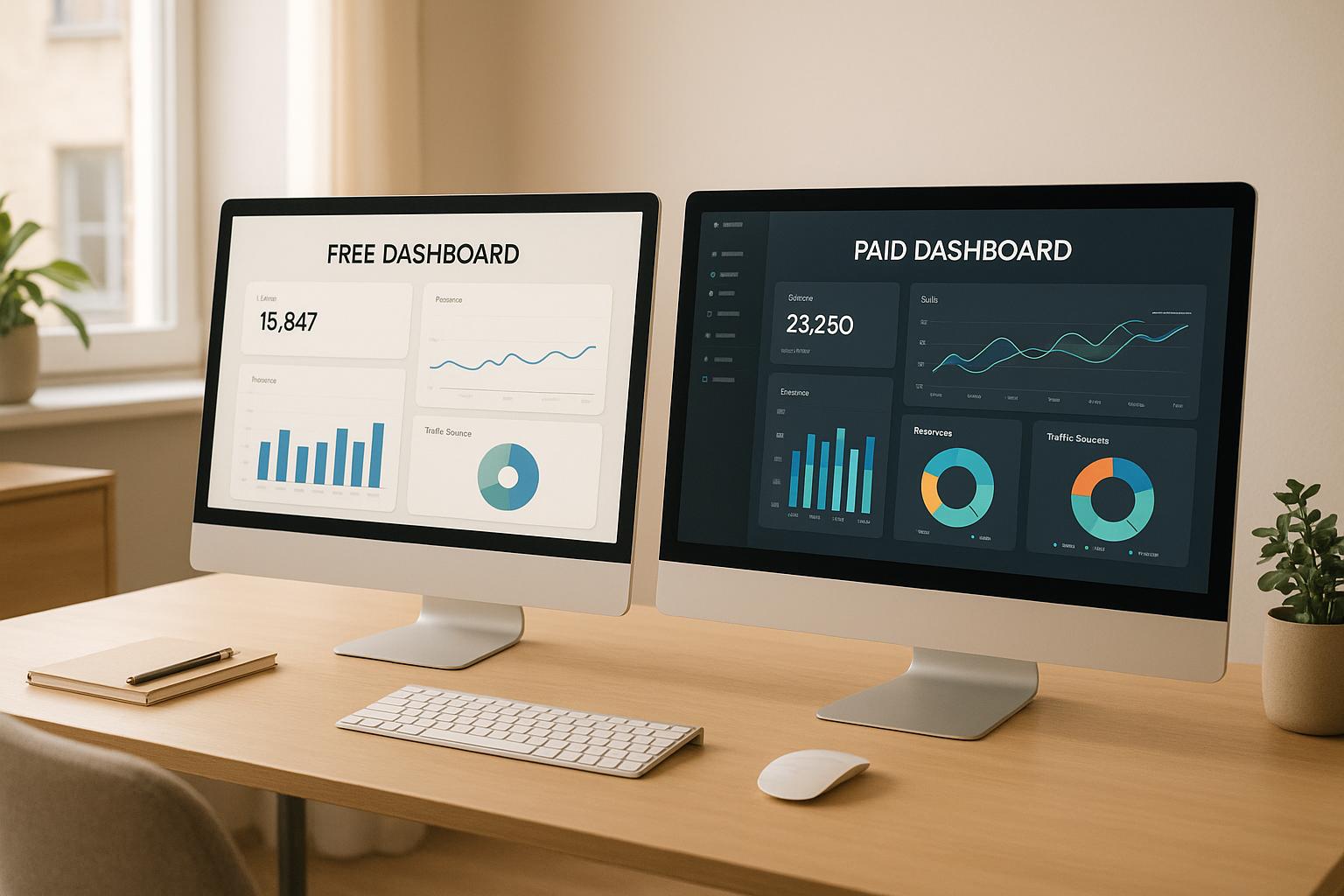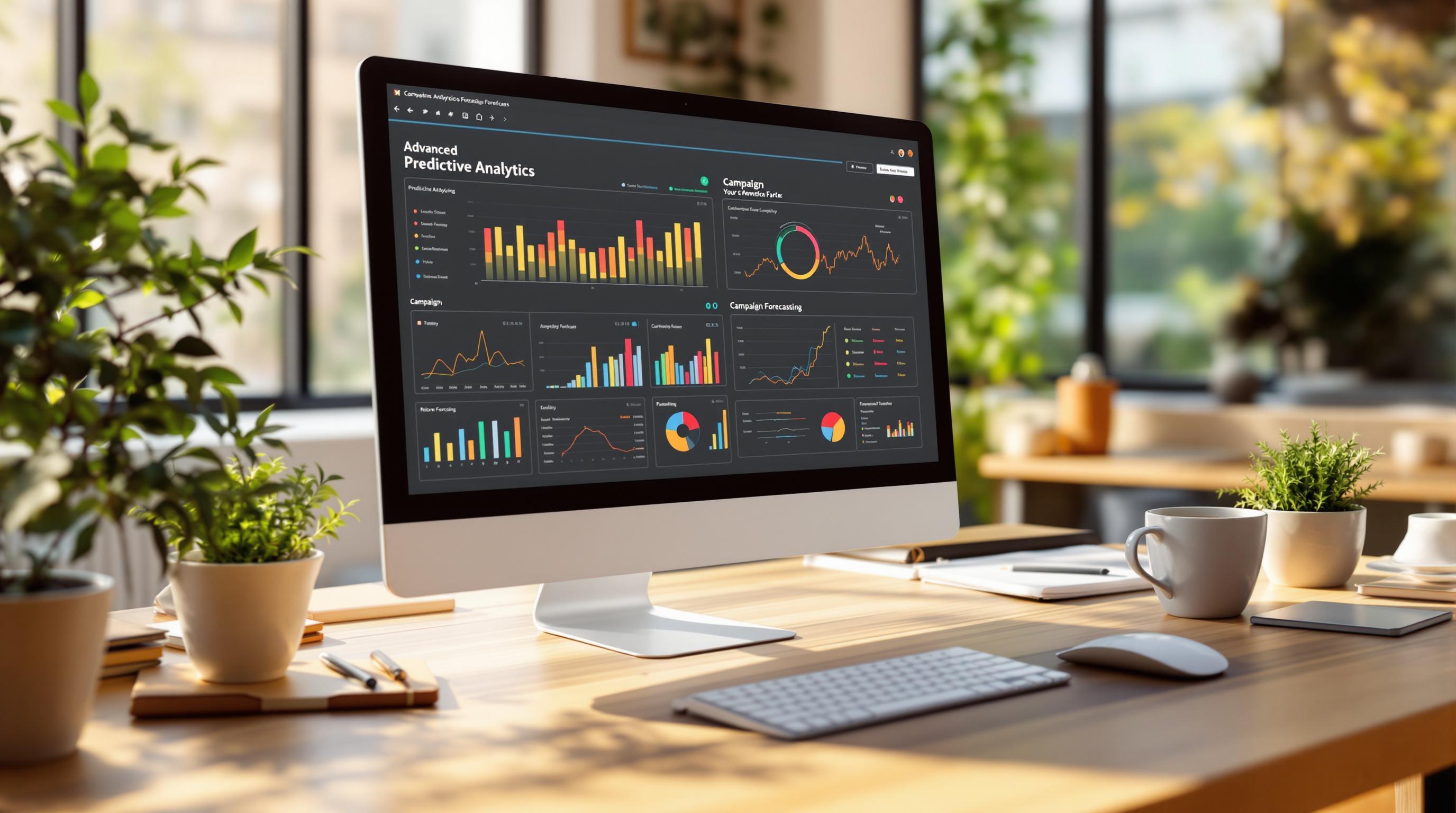Automated attribution tools help marketers understand which channels contribute to customer conversions. With customers interacting across multiple touchpoints, these tools provide data-driven insights to optimize campaigns and maximize ROI. Popular platforms like Google Analytics 4, Amplitude, AppsFlyer, Mixpanel, Adinton, and LeadsRx stand out for their ability to track user journeys, integrate data, and offer flexible attribution modeling.
Key Features:
- Google Analytics 4: Free option with advanced AI-driven insights, real-time data integration, and multiple attribution models.
- Amplitude: Focused on product analytics with flexible multi-touch attribution and advanced reporting.
- AppsFlyer: Ideal for mobile marketing, offering cross-device tracking and privacy-focused solutions.
- Mixpanel: Combines event tracking with predictive analytics, great for understanding user behavior.
- Adinton: AI-powered with budget optimization and cookieless tracking capabilities.
- LeadsRx: Universal tracking pixel, multi-channel integration, and strong privacy controls.
Quick Comparison:
| Tool | Best For | Key Strengths | Pricing |
|---|---|---|---|
| Google Analytics 4 | Businesses using Google tools | AI insights, free plan available | Free (GA360: $150,000/year) |
| Amplitude | Product-focused companies | Flexible rules, data history | Free up to 10M events/month |
| AppsFlyer | Mobile app marketers | Cross-device tracking, privacy features | Free plan, pay-per-conversion |
| Mixpanel | User experience tracking | Predictive analytics, easy integration | Free up to 1,000 users |
| Adinton | E-commerce businesses | AI optimizations, cookieless tracking | Starting at €300/month |
| LeadsRx | Multi-channel marketers | Universal tracking, privacy-first | Custom pricing |
These tools simplify understanding the customer journey, helping marketers allocate budgets effectively and improve campaign performance. Whether you're managing mobile apps, web platforms, or multi-channel strategies, selecting the right tool can transform your marketing efforts.
Mastering Multi-Channel Attribution: Top 5 Tools
1. Google Analytics 4
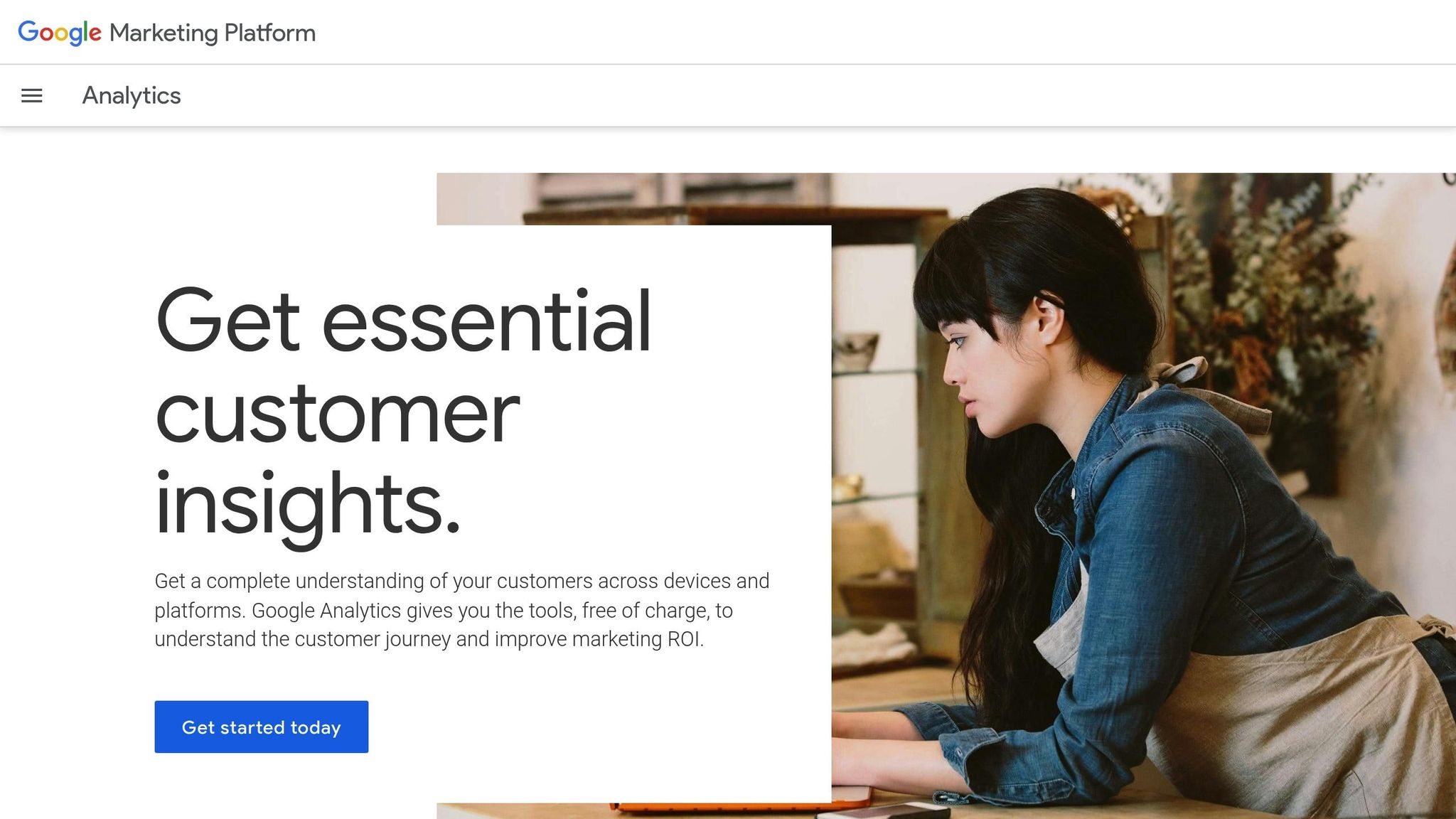
Google Analytics 4 (GA4) reshapes multi-channel attribution by unifying customer interactions across various touchpoints. This approach provides a clearer picture of which channels drive results, making it easier to identify and optimize high-performing strategies.
Real-Time Multi-Channel Data Integration
One of GA4’s standout features is its ability to merge data from multiple marketing channels into a single, cohesive view. This integration reveals how different channels contribute to the customer journey, rather than analyzing them in isolation. By centralizing data collection, marketers can align their strategies and fine-tune messaging across platforms, leading to sharper insights and more effective campaigns.
Flexible Attribution Modeling
GA4 offers a variety of attribution models tailored to different needs, including Data-driven, Cross-channel rule-based, and Ads Preferred Last Click options. These models allow marketers to assign credit to channels based on specific rules or advanced algorithms.
| Models | Basis | Rules |
|---|---|---|
| Data-driven | Algorithm | – |
| Cross-channel rule-based | Rules | Linear, Position-based, Time Decay, First Click, Last Click |
| Ads Preferred | Rules | Last Click |
The Data-driven model uses machine learning to evaluate over 50 touchpoints, such as device type, ad interactions, exposure order, creative elements, and time-to-conversion. This model assigns credit dynamically, based on what actually drives results. Marketers can further refine their analysis by customizing the lookback window, adjusting credit for interactions, applying specific rules, or setting a Time Decay half-life. Additionally, the Model Comparison Tool helps compare how different attribution models impact channel performance ratings.
AI-Driven Insights and Predictive Analytics
GA4 takes attribution a step further with AI-powered insights. Its data-driven attribution model uses machine learning to analyze both converting and non-converting paths, uncovering each touchpoint’s true impact. Factors like event timing, device type, creative assets, and ad exposure order are all considered.
"Attribution is the act of assigning credit for important user actions to different ads, clicks, and factors along the user's path to completing the action."
- Google Analytics Help
GA4 also bridges data gaps caused by users declining cookies or switching devices by employing modeled data. This approach ensures a more comprehensive view of the customer journey. Its AI even compares the likelihood of conversions between ad-exposed users and a control group, offering more precise insights than traditional rule-based models. By default, GA4 recommends using the data-driven model to review entire conversion paths, rather than focusing solely on high-level metrics.
2. Amplitude
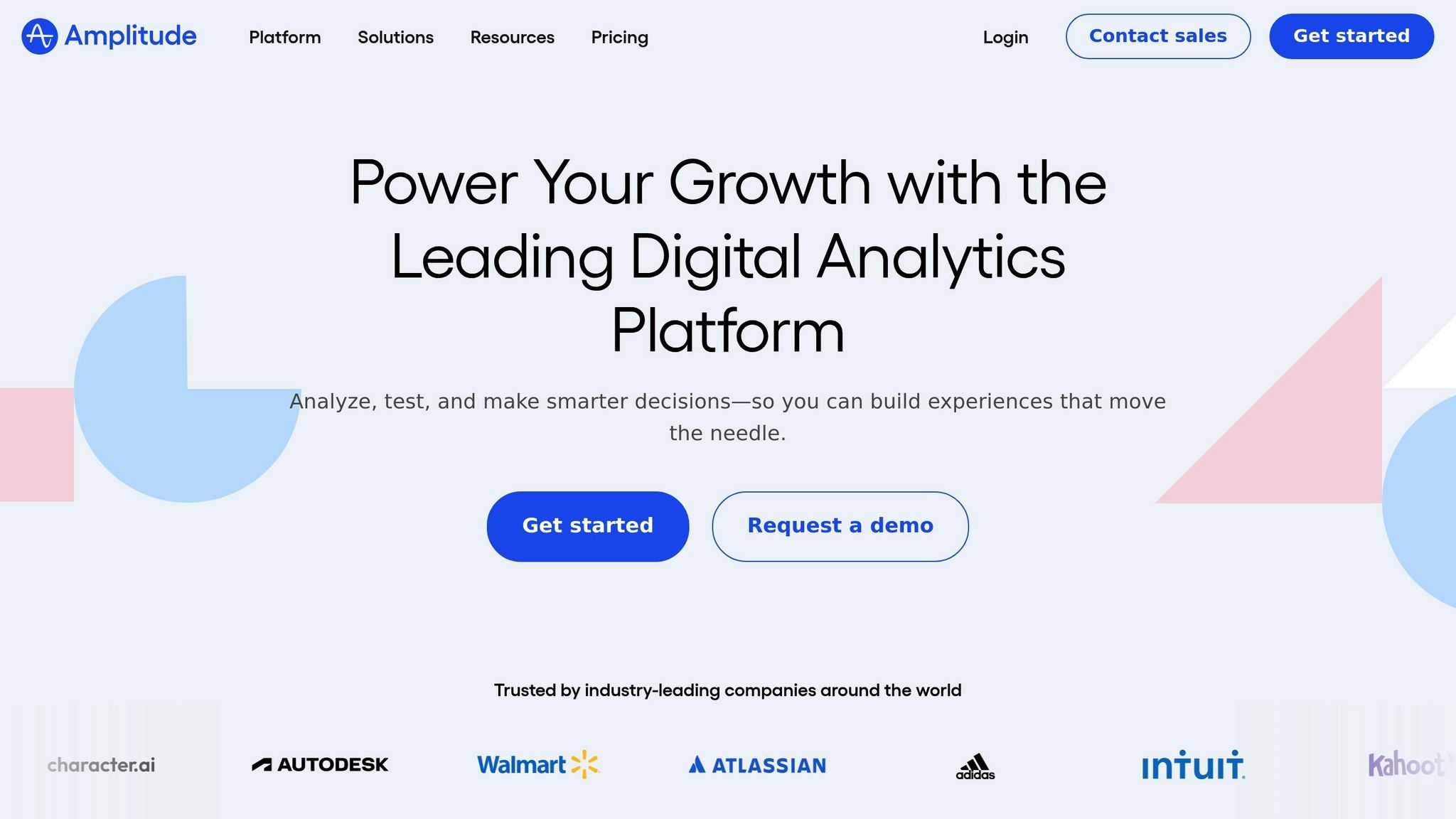
Amplitude transforms the data you’re already collecting into meaningful insights, eliminating the need for additional setup. This makes it an efficient tool for businesses eager to implement attribution quickly and effectively.
Real-Time Multi-Channel Data Integration
Amplitude stands out by seamlessly applying attribution models to your existing, timestamped data without requiring extra instrumentation. This streamlined process reduces setup delays while enabling accurate cross-platform attribution. For web tracking, Amplitude uses a JavaScript SDK, while mobile attribution is supported through integrations with measurement partners. Its Autocapture feature and Attribution API automatically record and store attribution events for up to 72 hours, ensuring precise, real-time tracking across multiple platforms.
Flexible Attribution Modeling
Amplitude offers robust multi-touch attribution with customizable rules that go beyond standard models. Pre-designed options include first touch, last touch, and linear models, but the platform’s real strength lies in its flexibility. Users can fine-tune allocation percentages, extend lookback windows beyond the usual 60 or 90 days, and exclude specific property values to tailor the analysis to their needs.
"Multi-channel attribution evaluates the impact of multiple marketing channels on customer conversion, providing insights into how each channel - such as social media, email marketing, and paid search - contributes to the overall success of a campaign." - Amplitude
Here’s a quick look at some of the attribution models Amplitude supports:
| Attribution Model | Lookback Window | Credit Distribution | Explanation |
|---|---|---|---|
| First Touch | 30 days | Google: 100% | All credit is assigned to the first interaction within the last 30 days. |
| Last Touch | 7 days | TikTok: 100% | All credit goes to the last interaction within the last 7 days. |
| Linear | 30 days | Google: 33%, Facebook: 33%, TikTok: 33% | Credit is evenly divided among all touchpoints. |
| J-Shaped | 30 days | Google: 20%, Facebook: 20%, TikTok: 60% | First and middle touches get 20% each, while the last touch receives 60%. |
| Custom (5%-20%-75%) | 30 days | Google: 5%, Facebook: 20%, TikTok: 75% | Fully customizable credit allocation to suit specific needs. |
This level of customization, combined with powerful visualization tools, allows businesses to gain a complete understanding of their conversion funnels.
Advanced Reporting and Visualization
Amplitude’s capabilities go beyond data integration and modeling, offering advanced reporting tools that merge marketing and product data. This unified approach provides a holistic view of the conversion funnel, helping businesses see not just how customers find them but also how they interact with their products. Marketers can compare different attribution models for the same conversion events, gaining valuable insights to refine their strategies and allocate resources more effectively.
"Regardless of which attribution method you prefer, having the ability to view the same events with different attribution models can help provide more context and guide future investment decisions." - Adam Greco, Product Evangelist, Hightouch
To ensure accurate data matching, Amplitude advises including the Advertising ID in all attribution requests and sending follow-up events with this data within 72 hours. Additionally, implementing data validation processes helps avoid discrepancies, ensuring reliable attribution across all channels.
3. AppsFlyer
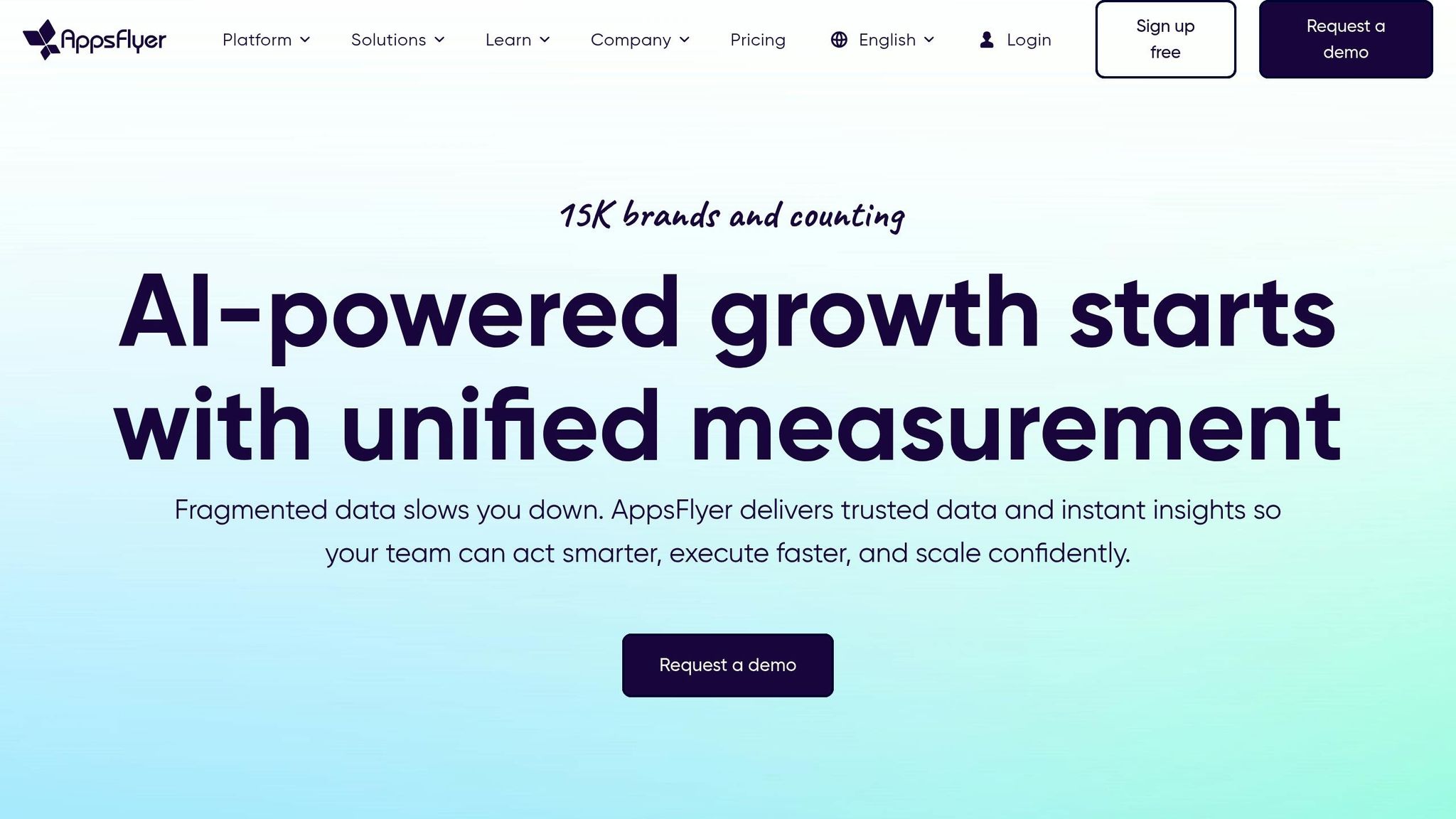
AppsFlyer focuses on mobile attribution, making it easier to track users across multiple devices. With 42% of media professionals highlighting cross-device attribution as a major challenge, AppsFlyer tackles this issue with advanced technology and privacy-focused solutions.
Flexible Attribution Modeling
AppsFlyer offers a variety of attribution methods, including click attribution, view-through attribution, as well as deterministic and probabilistic approaches. Together, these methods create a clearer picture of user journeys, even when device identifiers are unavailable. The platform’s multi-touch attribution models go beyond last-click methods by assessing the value of each touchpoint in the user’s journey. Additionally, AppsFlyer automates the distribution of credit across marketing clicks and impressions, removing the guesswork from campaign optimization.
Advanced Reporting and Visualization
AppsFlyer doesn’t just stop at attribution - it provides marketers with detailed reporting and analytical tools to dive deeper into performance metrics. Intuitive dashboards reveal insights into user engagement and conversion paths, offering a full view of the customer lifecycle. With improved data accuracy, the platform ensures that privacy standards remain a top priority.
Data Privacy and Security
Protecting data is central to AppsFlyer’s operations. The company adheres to rigorous security protocols, including SSAE 16 SOC2 and ISO standards, which are reviewed annually. Features like its Aggregated Advanced Privacy solution, Privacy Cloud, Data Clean Room, SK360, and granular privacy controls ensure compliance while maintaining precise attribution. Integrated with Apple’s SKAdNetwork framework, the platform provides insights into in-app events, user engagement, and cohort analysis - all while respecting user privacy.
As a data processor, not a data owner, AppsFlyer avoids using end-user personal data for its own purposes. It doesn’t sell, buy, or license such data. Customers have full control over how data is collected and configured, with clear contractual limits on handling sensitive information.
4. Mixpanel
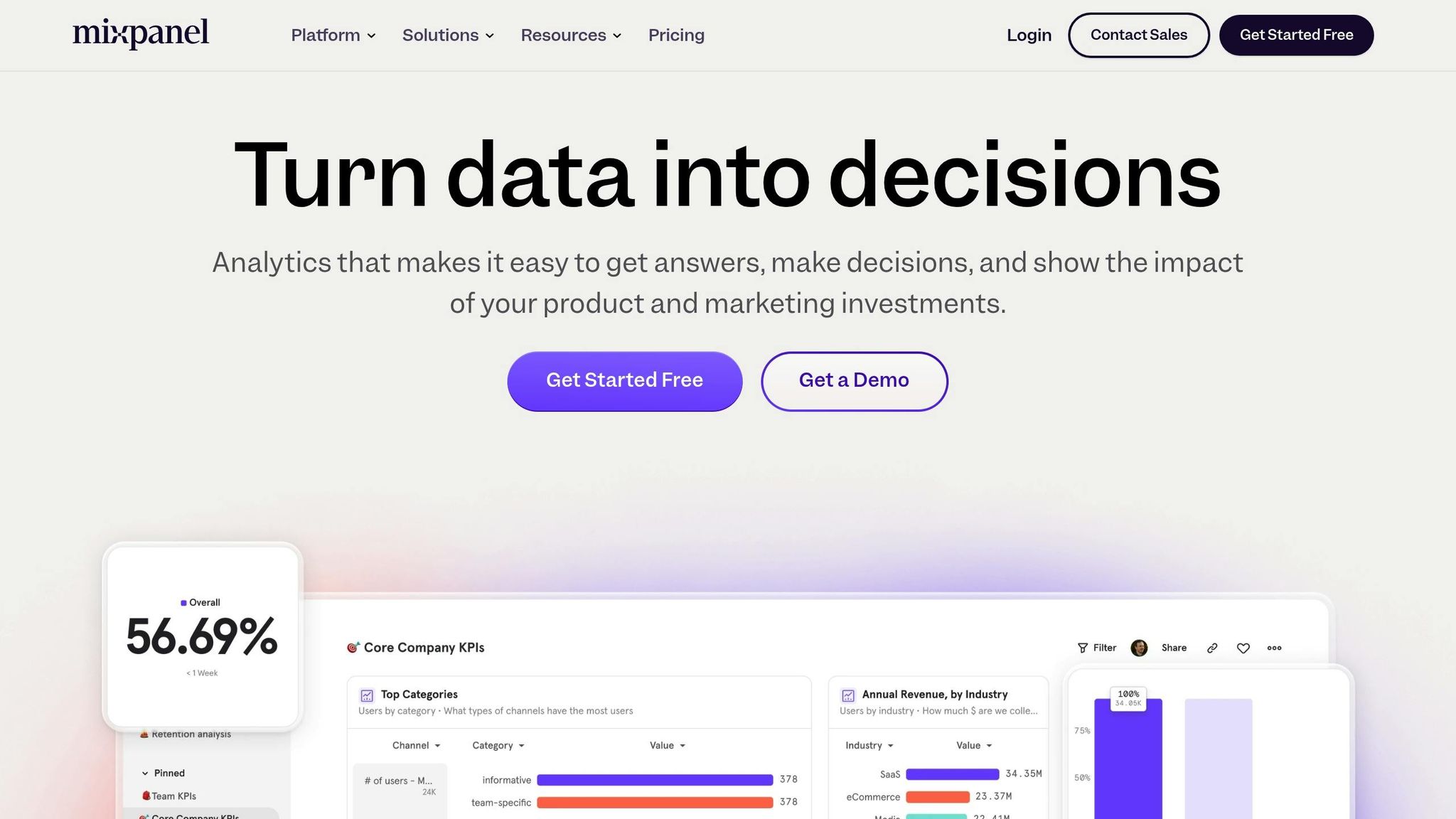
Mixpanel is an analytics tool designed to help businesses track events and understand how various marketing touchpoints contribute to customer conversions. By combining event tracking with attribution analysis, it provides insights into the entire customer journey.
Real-Time Multi-Channel Data Integration
Mixpanel stands out for its ability to integrate data from multiple marketing channels. It connects seamlessly with platforms like Facebook Ads, Google Ads, Mailchimp, Marketo, Salesforce Marketing Cloud, and Segment. Its JavaScript library automatically captures UTM parameters from both initial visits and ongoing sessions, making it especially useful for managing complex, multi-channel campaigns. For mobile apps, Mixpanel integrates with attribution tools to track sources for installs, uninstalls, and downloads. Additionally, its Segment integration streamlines data collection across web, app, and marketing platforms, creating a unified view of the customer journey.
Flexible Attribution Modeling
Mixpanel offers more than just last-click attribution. It supports both single-touch and multi-touch models, allowing marketers to see how multiple touchpoints drive engagement and conversions. This approach provides a fuller picture of marketing performance. These attribution models directly feed into Mixpanel's reporting tools, offering deeper insights into campaign effectiveness.
Advanced Reporting and Visualization
With its robust reporting features, Mixpanel turns attribution data into actionable insights. Its customizable dashboards allow marketers to track how different touchpoints contribute to conversions and adjust strategies accordingly. Users can experiment with various attribution models, like linear and time decay, or create custom models tailored to their product's user journey. For example, one business fine-tuned its geographic targeting strategy and doubled its marketing ROI.
AI-Driven Insights and Predictive Analytics
Mixpanel leverages machine learning to predict user behavior. Its predictive analytics can estimate metrics like churn likelihood, conversion probability, and user lifetime value, helping businesses anticipate trends. The platform's AI also uncovers subtle patterns and early-stage interactions that traditional attribution models might miss. For instance, a mobile gaming studio used Mixpanel's AI to analyze player behavior and discovered that players who failed level 8 more than three times had a 67% chance of churning within 48 hours. This insight allowed the studio to intervene and retain at-risk players.
Mixpanel offers a free tier for up to 20 million events, with paid plans starting at $20 per month, making it accessible for businesses of all sizes.
sbb-itb-5174ba0
5. Adinton
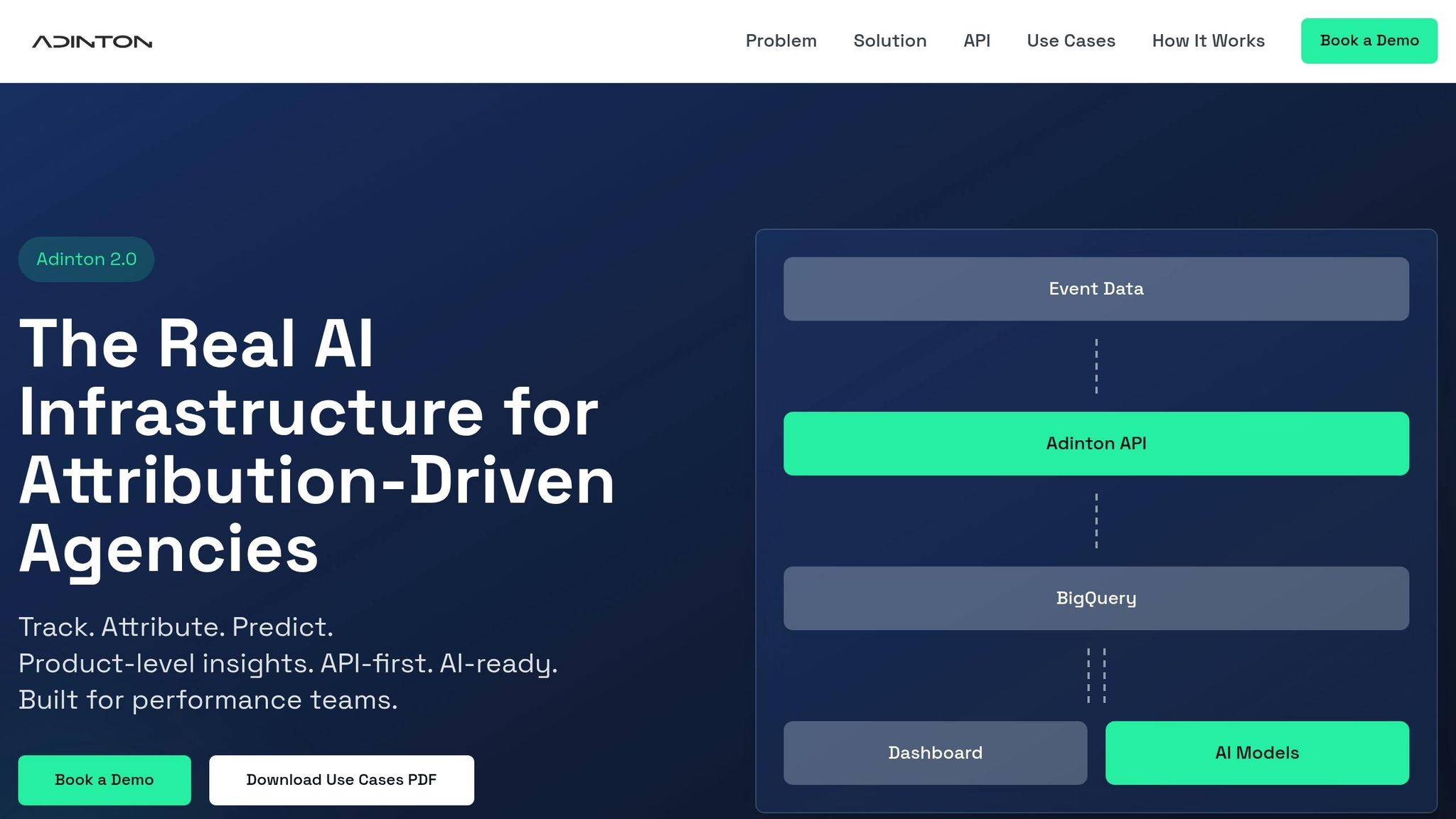
Adinton, like many top-tier tools, provides detailed attribution and real-time insights, but it stands out with its AI-powered optimizations. It tracks user interactions across multiple channels and automatically reallocates budgets to the campaigns that perform best.
Real-Time Multi-Channel Data Integration
Adinton brings together data from cross-device, cross-domain, and offline sources to provide a complete picture of marketing performance. It goes beyond simple click tracking by offering both online and TV attribution. This allows marketers to analyze visitor behavior in-depth, including the devices used, page views, traffic sources, search terms, and timestamps. This unified dataset enhances campaign tracking and integrates seamlessly with Adinton's modeling tools.
Flexible Attribution Modeling
Adinton's multi-touch attribution models are designed to deliver actionable insights for marketers. For example:
- Color Attribution: Analysis revealed that red performed 22% better on Meta, leading to creative adjustments that improved return on ad spend (ROAS) by 18%.
- Size Segmentation: Data showed that size S products converted 2.3× more effectively on TikTok, prompting dynamic ads that increased click-through rates (CTR) by 25%.
- Keyword ROI: The keyword "Premium jeans" generated 40% higher average order value (AOV), enabling smarter bidding strategies that boosted ROAS by 23%.
These insights allow marketers to fine-tune campaigns for better results.
Advanced Reporting and Visualization
Adinton’s reporting tools turn attribution data into practical insights, tracking every step from the initial touchpoint to final conversion. Key examples include:
- Cart Recovery: Analysis showed blue size M products had a 38% higher abandonment rate, leading to targeted retargeting that improved recovery by 20%.
- Geo Targeting: Insights revealed that colder zip codes purchased coats 3× more often, driving localized ads that increased conversions by 30%.
These reports feed directly into Adinton’s AI-driven analytics, paving the way for smarter marketing strategies.
AI-Driven Insights and Predictive Analytics
Adinton’s AI capabilities set it apart from traditional attribution tools. Its predictive algorithms classify traffic into six groups (A to F) based on purchase readiness, enabling marketers to customize campaigns for each segment. The platform’s AI Scoring Models predict conversions by product, location, and UTM parameters, helping businesses optimize ad spend and boost efficiency by 15%.
Starting at €300 (around $325), Adinton is a solid choice for mid-sized businesses looking to decode complex marketing data and make smarter budget decisions.
6. LeadsRx
LeadsRx supports over 5,000 brands and agencies with its advanced attribution platform, powered by its proprietary Universal Pixel™ technology. This tool captures a complete picture of marketing data while balancing real-time integration with strong privacy safeguards. It's an excellent choice for businesses seeking detailed, real-time insights into their campaigns.
Real-Time Multi-Channel Data Integration
The Universal Pixel™ from LeadsRx is designed to capture all inbound digital traffic to a website, no matter the source. This eliminates the need for re-tagging campaigns, allowing marketers to start collecting data immediately by placing the pixel on their website or using a tag manager.
"LeadsRx uses a proprietary Universal Pixel™ that captures 100% of in-bound traffic to your website no matter where it comes from."
LeadsRx integrates smoothly with popular e-commerce platforms like Shopify, Magento, BigCommerce, and WooCommerce. It also connects with major CRMs, including Salesforce, Pipedrive, and Infusionsoft. Beyond digital marketing, the platform supports multi-touch attribution across streaming audio and video platforms, including OTT and CTV, and even incorporates traditional media like linear TV and radio into its attribution models. This wide-ranging compatibility ensures businesses get a clear, unified view of their marketing efforts.
Flexible Attribution Modeling
LeadsRx goes beyond single-channel tracking by integrating both online and offline data, offering insights into the entire customer journey. Its multi-touch attribution capabilities allow marketers to see how different channels work together to drive conversions, providing insights that single-channel solutions can't match.
"LeadsRx technology allows us to talk to our clients about multi-touch campaigns. We talk about touchpoints, the sales funnel and the customer journey." - Michael Frischling, Co-Owner, VP, Steel City Media
This approach helps businesses understand the full path from the first interaction to the final conversion, offering a more complete picture of marketing effectiveness.
Advanced Reporting and Visualization
LeadsRx is frequently praised for its reporting features, which transform complex attribution data into actionable insights. These insights help marketers identify what’s working and adjust strategies accordingly.
"With LeadsRx, we are able to accurately see and adjust what's working and what's not working, shifting more to what is working and cutting out what is not working." - Verified reviewer in Broadcast Media
Another reviewer in Marketing and Advertising shared:
"With LeadsRx we have a compass to know which direction a campaign is going and get it back on course when necessary."
Dan Browdy, COO and VP at ZQuiet, highlighted the platform’s impact:
"It's been an invaluable tool to us to make sure our ad spends are working."
By turning data into clear, actionable insights, LeadsRx empowers businesses to make smarter marketing decisions.
Data Privacy and Security
LeadsRx takes privacy seriously, addressing growing concerns with its Privacy Studio™, launched in November 2021. This feature creates a Data Clean Room (DCR) to house anonymous and first-party data, giving IT teams full control over data governance while still enabling analytics through SaaS applications.
The platform uses an Isolation Pixel™, a first-party branded and hosted web tag, to collect data that is stored securely in the enterprise's dedicated Data Clean Room. This ensures data remains encrypted, secured, and fully controlled according to corporate policies, avoiding the risks of typical multi-tenant SaaS databases.
"With marketing teams collecting more and more first-party data about their consumers, storing this information in ways that allow complete, corporate data-governance is essential." - AJ Brown, co-founder and CEO of LeadsRx
LeadsRx supports a variety of cloud platforms, including Amazon Web Services, Google Cloud, IBM Cloud, Microsoft Azure, Oracle Cloud, DigitalOcean, and Rackspace Cloud. Its privacy-first approach also addresses concerns about third-party cookies, a pressing issue given that only 33% of Americans believe companies handle personal data responsibly, according to McKinsey & Company.
"At LeadsRx, we are dedicated to safeguarding your personal information... We employ robust security measures and technical controls to prevent unauthorized access." - LeadsRx Privacy Statement
Tool Comparison Table
Selecting the right automated attribution tool hinges on factors like your business size, budget, and specific marketing priorities. Below is a comparison of six widely-used tools, outlining their primary strengths and potential drawbacks for U.S.-based businesses.
| Tool | Best For | Pricing | Key Strengths | Limitations |
|---|---|---|---|---|
| Google Analytics 4 | Businesses already using the Google ecosystem | Free (GA360: $150,000/year) | Quick 15‑minute setup, 14‑month data retention, seamless Google Ads integration | Limited advanced attribution features on the free plan |
| Amplitude | Product-focused companies needing behavioral analytics | Free up to 10M events/month; Growth plan at $15,000/year | Unlimited data history, strong product analytics, flexible attribution modeling | More complex setup requiring developer support |
| AppsFlyer | Mobile app marketers focused on performance | Free plan available; Growth at $0.07/conversion | Comprehensive mobile attribution with fraud protection and real‑time data | Primarily mobile‑focused, limited web attribution |
| Mixpanel | Teams prioritizing user experience and ease of use | Free up to 1,000 monthly users; paid plans based on MTUs | Intuitive interface and robust event tracking | Higher costs for large user bases |
| Adinton | E-commerce businesses needing cookieless solutions | Contact for pricing | Cookieless tracking solution (feature details are limited) | Limited public pricing information |
| LeadsRx | Multi‑channel marketers needing comprehensive attribution | Contact for pricing | Comprehensive attribution capabilities | Custom pricing; requires sales consultation |
Market Trends and Considerations
The marketing attribution software market was valued at $3.53 billion in 2023 and is expected to grow to $9.13 billion by 2030, reflecting a 14.5% annual growth rate. This surge is fueled by the increasing complexity of marketing channels and the need for precise ROI measurement.
Implementation Complexity
Ease of implementation varies widely across these tools. For instance, Google Analytics 4 (GA4) can be set up in as little as 15 minutes without requiring developer assistance. On the other hand, Amplitude often involves a more time-intensive setup, requiring several days and developer support to establish proper data flows. This distinction is especially important for businesses with limited technical resources.
Data Retention and Analysis
Data retention policies also differ significantly. GA4's free plan limits data retention to 14 months, while Amplitude offers unlimited historical data - a critical feature for businesses that rely on long-term trend analysis.
Integration Capabilities
Each platform offers varying levels of integration with marketing tools, CRMs, and analytics systems. These integration options can influence how well the tool fits into your existing tech stack.
Adoption and Strategic Importance
Interestingly, only 45% of U.S. and UK marketers currently use multi-touch attribution to evaluate marketing effectiveness. However, this figure is rising, with 50% of companies incorporating multi-touch attribution into their strategies as of 2023. This shift highlights the growing emphasis on understanding customer journeys and optimizing marketing investments.
Pricing Dynamics for Enterprises
For larger organizations, pricing becomes a pivotal factor. GA360's $150,000 annual cost provides access to advanced features and dedicated support. Meanwhile, Amplitude's Growth plan starts at $15,000 per year, offering scalability for enterprises.
Why Attribution Matters
A notable 60% of marketing professionals emphasize attribution as critical for understanding high-value customer journeys. Choosing the right tool isn’t just a technical decision - it’s a strategic move that can shape how effectively your business identifies and nurtures its most valuable customers.
Conclusion
Automated attribution tools have become a must-have for modern marketing teams navigating the complexities of today’s digital environment. Despite their importance, only 17% of marketers currently evaluate the performance of all their digital channels together. This leaves a huge opportunity for businesses to gain an edge by adopting more comprehensive attribution strategies.
Data-driven attribution models are proving their worth, delivering an average 6% increase in conversions compared to older, traditional methods. These tools shine because they provide a complete view of the customer journey, capturing the touchpoints that single-touch models often overlook.
"Multi-channel attribution is no longer a luxury for marketers - it's a necessity. By unlocking insights into customer journeys and improving cross-channel marketing analysis, it transforms how businesses approach strategy and execution."
- Quantum Metric
This level of precision doesn’t just fine-tune campaigns - it reshapes entire marketing strategies. Attribution tools go beyond tracking conversions; they help marketers identify which touchpoints drive engagement, sales, and customer loyalty. With creative quality contributing up to 56% of a campaign's sales ROI, accurate attribution data is critical for optimizing both channel performance and creative efforts.
As privacy regulations grow stricter and the digital world shifts toward a cookieless future, automated attribution tools offer a level of accuracy and clarity that manual tracking simply can’t achieve. They eliminate duplicate credit, enable real-time campaign adjustments, and encourage collaboration across marketing, sales, and customer experience teams by centralizing data into a single source of truth.
For businesses looking to enhance their marketing strategies, the Marketing Analytics Tools Directory (https://topanalyticstools.com) is an excellent starting point. This platform helps businesses of all sizes compare tools for real-time analytics, campaign tracking, audience insights, and attribution modeling. Whether you’re considering GA4 for its simplicity or Amplitude for its advanced enterprise features, there’s a solution tailored to your needs.
FAQs
How do automated attribution tools address privacy challenges in a cookieless world?
In a world without cookies, automated attribution tools address privacy challenges by using privacy-first strategies like device fingerprinting and deterministic attribution. These techniques emphasize user anonymity and depend on first-party data, ensuring they align with privacy regulations like GDPR and CCPA.
Shifting away from third-party cookies, these tools concentrate on tracking user interactions in a manner that respects privacy while still providing reliable insights. This balance allows businesses to uphold audience trust and stay aligned with changing data privacy expectations.
What’s the difference between single-touch and multi-touch attribution models, and how do they influence marketing strategies?
Attribution models play a key role in understanding how marketing efforts influence customer decisions. Single-touch attribution gives all the credit for a conversion to just one interaction - usually the first or the last. While this method is simple to use, it only tells part of the story, leaving out the other steps in the customer journey.
On the other hand, multi-touch attribution spreads the credit across multiple touchpoints. This approach paints a fuller picture of how customers interact with your brand, providing insights into the entire journey.
Choosing between these models can shape your marketing strategy. Single-touch attribution might push you to focus heavily on either the initial or final interactions. Meanwhile, multi-touch attribution promotes a more balanced view, allowing you to fine-tune efforts across all stages of the customer journey for stronger overall performance.
What should businesses consider when choosing an automated attribution tool to meet their marketing goals and budget?
To select the best automated attribution tool for your business, start by clearly defining your marketing objectives and setting a budget. Look for tools that offer multi-channel tracking, real-time analytics, and seamless integration with your existing platforms. Additionally, make sure the tool supports the attribution model you plan to use, whether that's multi-touch or single-touch.
When evaluating costs, think about more than just the upfront licensing fees. Consider how well the tool scales with your business and whether it can lead to long-term savings by improving your campaign performance. Matching the tool's features to your specific needs and budget will help you get the most out of your investment in marketing attribution.
